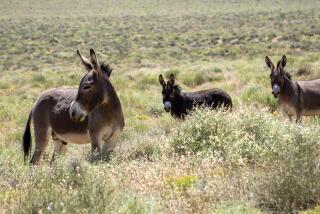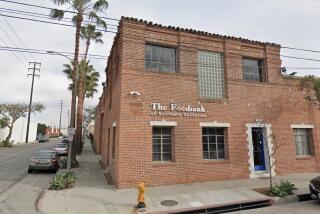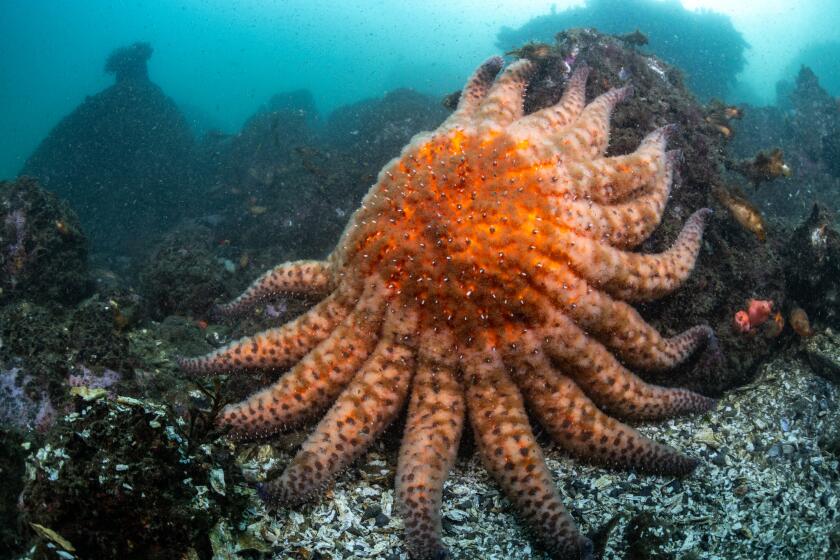
- Share via
Inside a subzero freezer at a Northern California pet hospital sit rows of carefully labeled bags of fresh frozen plasma. Each pouch could save a pet’s life: a retriever that ingested poison, a corgi with a bleeding disorder, a puppy with parvovirus.
While the pouches each look the same, their straw-colored contents come from starkly different places. Some of the blood products are from dogs like Augustus, a 55-pound Belgian Malinois whose owner signed him up to donate blood at a canine community blood bank, which is modeled after the human volunteer system.
Other bags hold a more controversial history. Their contents come from donor kennels in California, where hundreds of dogs and cats live in “closed colonies” as full-time blood suppliers. These captive animals have long provided a steady stream of blood to meet the state’s surging demand for advanced veterinary care.
For decades, California veterinarians were required to buy blood exclusively from closed colonies in the state, a system regulators decided would ensure the products were safe and the donors free of diseases. Veterinary hospitals that collected blood in-house for their patients weren’t allowed to sell it.
But in 2021, state lawmakers declared closed colonies inhumane because the animals are held captive. They vowed to replace them with community blood banks and ordered that the state’s inspection reports — long sealed — be open to public scrutiny.

The law, however, included critical caveats: Only closed colonies for dogs would be shut down, and that phaseout would begin after community blood banks — where owners volunteer their pets to give blood — consistently matched their output.
After three years, they’re not even close. California’s closed colonies continue to supply the bulk of canine blood sold in the state.
Without the blood supplied by captive donors, veterinarians say, many other dogs in critical need would die from injuries and disease. But this poses a dilemma for those who want to see the closed colonies shut down.
The Times found that the closed colonies produced more than 97% of canine blood products — including whole blood, red blood cells and fresh frozen plasma — sold in the state through September of this year. That divide will leave California tethered for many more years to a system it vowed to leave behind.
“I don’t want to see captive dogs,” said Ken Pawlowski, clinical director of one of three community blood banks in the state licensed to sell blood products. “However, it’s a necessary evil at this point.”
Inspection reports, along with emails, court depositions and other records reviewed by The Times, exposed new details about how colonies operate, including the fact that there is no regulatory limit on the number of years a healthy animal can be kept as a donor. Nor are the colonies required to disclose how many animals are euthanized annually.

Records for the only remaining company with closed colonies in California, Animal Blood Resources International, show its facilities draw roughly a pint of blood every three weeks from dogs that weigh at least 50 pounds. The blood is then packed in ice and taken to a small town outside Sacramento for processing and, in some cases, separation into fresh frozen plasma and other components. The company’s pricing sheet for veterinarians, both in California and elsewhere, lists blood products for roughly $100 to more than $700.
State inspections don’t include the breed of the dogs used, but one facility’s local kennel license listed Labrador retrievers, greyhounds, Great Danes, Pyrenees and other breeds. The dogs are kept in pens large enough that federal law does not require them to be let out for exercise, though each colony reported they do “as needed.”
“This is our first opportunity to peek behind the curtain,” said Jennifer Fearing, a longtime animal welfare lobbyist in California, who helped pass the law.
Fearing said because closed colonies operated in secret prior to the law, little was known about their operations, including that dogs can be kept as full-time donors indefinitely.
“This is what we feared, but could never verify,” she said.

Pat Kaufman was living in Lompoc in the mid-1970s when her 12-year-old beagle mix, Jake, was diagnosed with splenic cancer and needed surgery. The vet’s office called with good news after removing Jake’s spleen: He was done and ready to be picked up.
In the half-hour it took Kaufman to get there, Jake hemorrhaged and died. He needed a transfusion to survive, and there was no blood to give him.
“They were like, ‘Well, there’s no such thing as blood banks for dogs,’” Kaufman told The Times. “I said, ‘Maybe there should be.’”
A decade or so later, Kaufman met a veterinarian who wanted to start an animal blood bank, and they went into business.
Kaufman said she originally envisioned a model similar to how people give blood — pet owners could volunteer their dogs and cats to donate — but that state regulators pumped the brakes on the idea.


Frankie receives a treat after his owner brought him in to donate blood at Insight Veterinary Wellness Center, a 24-hour pet hospital that opened a canine community blood bank. (Allen J. Schaben / Los Angeles Times)
The donor animals would need to live in closed colonies, kennels that restricted where they could go to prevent exposure to disease. She proposed taking unwanted dogs out of shelters to become donors, and later placing them in homes. “Protests ended that,” she recalled.
California long required veterinarians to buy blood products from these closed colonies. Two companies served as the only source of the state’s animal blood sales: the one Kaufman founded, which is now called Animal Blood Resources International, with offices in Dixon, Calif. and Michigan, and Hemopet, which closed its nonprofit Garden Grove blood bank this year.
Kaufman, who retired a few years ago and sold the company to Chief Executive Scott Horner, said she approved of the shift toward volunteer blood banks, but said that kind of setup would not collect enough blood to meet demand.
“It’s a wonderful idea, except it’s probably impossible,” Kaufman said.

The company Kaufman founded became one of the largest commercial blood banks in the country, now contracting with three closed colonies in Northern and Central California that are inspected annually by the California Department of Food and Agriculture. The colonies housed about 650 donor dogs and 530 donor cats, according to 2022 inspection reports. Inspection records show one contract colony reported in 2019 that nearly all of its donor dogs were bred into the program.
State inspectors noted last year that Animal Blood Resources International sold blood collected from an animal with heartworm. Earlier inspection reports obtained by The Times found water pooling in the bottom of the barrels dogs slept in at one colony, and “many flies” in a blood collection area at another.
The company’s spokesperson, Dan Kramer, said it self reported the heartworm diagnosis and the dog was removed from the donor pool. Since heartworm can’t be transmitted via transfusion, he said, no recipient dogs were affected. He said the inspector likely noticed water pooling after shelters had been cleaned and that the company implemented the state’s suggestion for additional fly strips in the area that had flies. He said no citations were issued for any of those incidents, and that the company has never had an animal welfare violation.
One contractor, Feather Ranch Kennels, is a 200-dog closed colony in Los Banos surrounded by empty, barren farmland. Several rows of covered chain-link pens house dogs on the property. From the road one recent morning, black and white Labradors could be seen romping about inside pens, excitedly barking and wagging tails.

On its website, Feather Ranch advertises puppies, training programs for hunting dogs and adoption programs. There’s no mention of a blood bank. Owner Phil Mueller declined to talk with reporters.
In 2009, he began raising a colony of donor dogs to provide blood throughout the country and internationally, Merced County records show. State inspection reports reviewed by The Times show that Feather Ranch draws blood from each donor dog every three weeks.
State inspectors last year identified a blood donor with “undocumented lameness” that was subsequently removed from the donor pool and scheduled to see a vet.
In the Tehama County town of Corning, Skyline Sporting Dog operated a 281-dog and 336-cat donor kennel that also provides blood products to Animal Blood Resources International, according to a 2022 inspection report. Owner Tom Wright told The Times in a brief interview that he was preparing to go out of business.
“I’m tired of it,” he said. “Tired of animal rights trying to make us all into criminals anytime we work with animals. So I’m done.”
He said the push to shut down closed colonies has had a major impact on California’s blood supply.
“They’re going to get what they want, and there is not going to be any blood available in California anymore,” he said. “We have huge back orders.”

Wright did not elaborate on pressure from animal rights groups or respond to follow-up queries. However, Kramer said the state conducted two investigations — of Animal Blood Resources International and Hemopet — based on allegations by animal rights groups that the state determined to be unfounded.
Another inspection last year noted that Skyline was told to avoid collecting blood from pregnant animals to conform with best practices. CDFA spokesperson Steve Lyle said several pregnant animals were identified at the facility, which also breeds dogs, prompting concerns about their potential use as donors. Drawing blood can affect the health of the dog and its unborn puppies.
Kramer said there was a “very rare” situation where the donor animal had intentionally been bred but not yet tested positive for being pregnant when blood was drawn.
“Once it was discovered the donor was pregnant, she was removed from the donor pool, as is common practice. Since this event we have modified our practice, and female donors are removed from the donor pool prior to breeding,” he said.
Kramer said donor dogs receive care “as good or better than any pet at home.” He said the company’s mission is to help save the lives of pets in California, which has the most rigorous rules in the country for animal blood banks, and that each facility also has an oversight veterinarian.
“We’re very proud of our 30-year record of doing so by supplying a safe, ethical and reliable source of veterinary blood products for which there is no viable alternative,” he said.
Since the new law, he said, there’s been a 32% reduction in the volume of dog blood products supplied to California vets.
“Anyone who understands the kinship and bond many owners have with their pets knows the last thing any pet lover should ever hear is their beloved animal died simply because there wasn’t an adequate supply of blood available in an emergency,” he said. “But that’s exactly the danger of what these activists are promoting.”
Grant Miller, of the California Veterinary Medical Assn., said the veterinary community is divided on whether one model of blood donors is better, but that there is an overwhelming consensus that there is simply not enough blood.

Meghan Respess, national director of blood banking at BluePearl Veterinary Partners, said it can take up to six months to get some products, especially for cats. She said BluePearl’s 110 pet hospitals perform approximately 8,000 transfusions annually. Its network of community blood banks across the country, including two in California, have roughly 700 dogs and 300 cats whose owners volunteer them to donate. But its hospitals would need three times the number of donors to reach its goal of supplying all of its own blood products in five years.
“It’s definitely a significant issue that can impact the ability to treat some pets,” she said. “Maybe they have to go elsewhere. Maybe they have to wait a longer period of time to get their product, assuming it can be shipped and it can be found.”
Miller said it’s clear that shutting down the closed colonies now would be disastrous for the health of pets in California.
“It would not only be a devastating effect; it would be a long-lasting, a perpetual issue for animals in California,” Miller said. “That would be very scary for us.”

Gov. Gavin Newsom didn’t mince words. When lawmakers sent him a bill in 2019 to allow volunteer blood banks to operate alongside donor colonies, the governor delivered a decisive veto. He said it didn’t go far enough.
Newsom wanted to shut down closed colonies completely, saying in his veto message dogs are “kept in cages for months and years to harvest their blood for sale.”
It took two more years before the bill phasing out closed colonies would arrive on his desk. With his signature, the state also rolled back sweeping privacy rules that had barred the disclosure of inspection reports and other records.
When The Times sought those inspection reports last year, a state attorney said in a court declaration that California regulators and Animal Blood Resources International disagreed about what should be redacted. CDFA spokesperson Steve Lyle said “when negotiations broke down,” the company sued the state to keep key details private, which according to records included where dogs are kept and how many are in each colony.
The Times intervened in court, and a judge ultimately ordered the state to release many of the details.
The records indicate that the state does not set a limit on how many years a dog can be kept as a blood donor and deems adoption programs optional. Lyle said officials review protocols from all licensees annually, and “corrective actions are taken where necessary.”

While the new law surrounding closed colonies was also intended to increase transparency, state officials last year began omitting most of the information that previously had been included in inspection reports, such as the number of animals housed at each facility and the number of annual animal deaths.
Lyle said the state updated its format for inspection reports to “emphasize key topics and streamline later review” in anticipation of the establishment of new blood banks. The new format was modeled after federal inspection reports, he said. Federal inspection reports, however, include the number of dogs at each facility.
Lyle said that the state agriculture department has proposed stricter oversight that would require closed colony blood banks to report quarterly on the status of all animals, including those euthanized or adopted “once their role in the program concludes.” But the regulations would not limit how long a healthy dog or cat can be kept as a donor.
When lawmakers were considering allowing volunteer blood banks in California, Jean Dodds, president of Hemopet, whose blood bank shuttered this year, bristled at the idea that closed colonies such as hers — which had 86 donor dogs in 2022 — were inhumane. Dodds, who was unavailable for comment, warned lawmakers of the need for strict donor guidelines if California moved to a volunteer model.
“We need to make sure that the blood is checked, that the donor is checked either a few days before a donation, or that the blood that they donate is checked for these infectious diseases every time they donate to make sure that we don’t cause pain and suffering and even, God forbid, death of an ill recipient animal,” Dodds said during a legislative hearing in 2021.

- Share via
The corgi panted rapidly, her wide eyes fixed on the bustling surgical room at Insight Veterinary Wellness Center in the Sacramento suburb of El Dorado Hills.
An empty bag of fresh frozen plasma hung from her metal crate door — a lifeline she would need during a routine spay procedure due to a blood clotting disorder. The plasma came from the hospital’s new community blood bank.
For Pawlowski, clinical director of the blood bank and pet hospital, the corgi’s successful transfusion was the culmination of years of work that included guiding the blood bank law through the Legislature. He knew it would take time for a community donation model to outpace the colonies, but he was stunned to see the divide when provided the figures by The Times.
“Holy criminy,” he said. Through September of this year, the state’s three community blood banks sold 25,868 milliliters of whole blood, red blood cells and fresh frozen plasma, while closed colonies sold 981,350.
Kimberly Carlson, owner of another of the community blood banks, Brave Unity Blood Bank for Animals in the Bay Area, said it will be years before community blood banks catch up.
“It’s hard to get them up and running, and it’s hard to get people to volunteer their pets [to be donors],” said Carlson, whose blood bank opened last year.
Since Insight veterinary center opened in May, its staff has evaluated 84 potential donor dogs. Disease screenings, temperament tests and blood type preferences left them with 16 regular donors so far that they hope will come in four times a year.
One of those donors was a lifeline for Alicia Collins.
In May, her 3-year-old Staffordshire bull terrier was dying after a complication during a C-section. Reign had hemorrhaged and been resuscitated during the delivery, but the clinic did not stock blood.
Staff placed the limp dog in her backseat and told her to hurry.
She drove 30 minutes to Insight, where Reign received three bags of blood products. Two came from a Doberman named Zeus, a regular donor at the hospital.
The third was pulled from a freezer with older inventory: fresh frozen plasma from a full-time donor dog in one of California’s closed colonies.
More to Read
Sign up for This Evening's Big Stories
Catch up on the day with the 7 biggest L.A. Times stories in your inbox every weekday evening.
You may occasionally receive promotional content from the Los Angeles Times.













